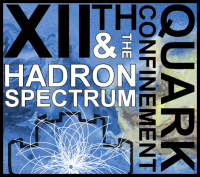Conveners
Special Section Future Perspectives, Upgrades, Instrumentation
- Stefanos Leontsinis (University of Colorado Boulder (US))
Special Section Future Perspectives, Upgrades, Instrumentation
- Pasquale Di Nezza (Istituto Nazionale Fisica Nucleare Frascati (IT))
ALICE (A Large Ion Collider Experiment) is studying the physics of strongly interacting matter, and in particular the properties of the Quark-Gluon Plasma (QGP), using proton-proton, proton-nucleus and nucleus-nucleus collisions at the CERN LHC (Large Hadron Collider). The ALICE Collaboration is preparing a major upgrade of the experimental apparatus, planned for installation in the second...
ALICE is the only LHC experiment specifically devoted to the study of ultra-relativistic heavy ion collisions. Its main goal is to identify and study a new state of matter, le Quark Gluon Plasma (QGP), where quarks and gluons are deconfined, which might have existed during the first instants of the Universe. One of the most powerful signatures for QGP study is the suppression, within this hot...
The muon g-2/EDM proposed experiment at J-PARC is a promising and innovative attempt at the field of Precision Physics. The sensitivity goal of 0.1ppm will test the limits of our current understanding, and may probe for BSM observations.
Our project seeks out to investigate the computational techniques required by the experimental process.
The GEANT4 framework was used to simulate the...
In high energy physics experiments a CsI photocathode coupled to a gaseous detector is used in most of the RICH detectors to identify charged hadrons. These RICH detectors have shown to be efficient and stable over long periods of time. A review of the important RICH detectors used around the world, and the technology behind them, will be shown.
The main goal of the CBM experiment at FAIR is to study the behaviour of nuclear matter at very high baryonic density in which the transition to a deconfined and chirally restored phase is expected to happen. The promissing signatures of this new state are the enhanced production of multi-strange particles, production of hypernuclei and dibaryons. Theoretical models predict that single and...
The Large Hadron electron Collider (LHeC) is a proposed facility which will exploit the new world of energy and intensity oered by the LHC through collisions with a new 60 GeV electron beam. Designed for synchronous operation with the other LHC experiments, the LHeC will be a high luminosity ep and eA collider with a wide ranging physics program on high precision deep inelastic scattering and...
Report at the Session: Future Perspectives, Upgrades, Instrumentation
Vertex detector for open charm measurements with NA61/SHINE at SPS at CERN
G.A.Feofilov $^1$$^†$ (for NA61/SHINE Collaboration)
(1) Saint-Petersburg State University
$^†$ E-mail: feofilov@hiex.phys.spbu.ru
Search for the critical point of strongly interacting matter and studies of the onset of deconfinement are...
The Micro Vertex Detector (MVD) will consist of four planar detector stations located at 5cm to 20cm downstream the target.
Its design is driven by the challenge to identify the decay vertices of particles carrying open-charm, which calls for a high spatial resolution ($\sim 5\mu m$) and a very light material budget of $0.3\%\ (0.5\%)\ X_0$ for the first (following) stations.
To match these...
Modern and future heavy-ion experiments are focused on measurements of very rare particles at interaction rates up to 10 MHz with data flow of up to 1 TB/s, that cannot be fully stored on currently available storage devices. The data flow should be reduced by selecting collisions with potentially interesting physics. Therefore, full reconstruction of the collision topology including...
One of the most challenging questions in contemporary physics is why and how quarks are confined into hadrons. The electromagnetic structure of hadrons, parameterised in terms of electromagnetic form factors, EMFF's, can provide a key.
The focus of this talk is baryon EMFF's. EMFF's have been a powerful tool in understanding the structure of nucleons for more than 60 years but the new...
In the ever increasing pile-up of the Large Hadron Collider environment the trigger systems of the experiments have to be exceedingly sophisticated and fast at the same time in order to increase the rate of relevant physics processes with respect to background processes.
The Fast TracKer (FTK) is a track finding implementation at hardware level that is designed to deliver full-scan tracks...
